Related Research Articles

The Avro Anson is a British twin-engined, multi-role aircraft built by the aircraft manufacturer Avro. Large numbers of the type served in a variety of roles for the Royal Air Force (RAF), Fleet Air Arm (FAA), Royal Canadian Air Force (RCAF) and numerous other air forces before, during, and after the Second World War.

RAAF Station Archerfield was a permanent Royal Australian Air Force station at Archerfield Airport in Brisbane, Queensland, Australia, from 1939 to 1956.

No. 14 Squadron was a Royal Australian Air Force maritime patrol squadron of World War II. It was formed in 1939 and was based in Western Australia throughout the war. While it conducted many patrols over the waters off Western Australia, it did not see combat. The squadron was disbanded in December 1945.

No. 12 Squadron was a Royal Australian Air Force (RAAF) general purpose, bomber and transport squadron. The squadron was formed in 1939 and saw combat in the South West Pacific theatre of World War II. From 1941 to 1943, it mainly conducted maritime patrols off northern Australia. The squadron was based at Merauke in western New Guinea from November 1943 to July 1944, when it was withdrawn from operations. After being re-equipped, it operated as a heavy bomber unit from February 1945 until the end of the war. The squadron continued in this role until it was redesignated No. 1 Squadron RAAF in February 1948. The squadron was reformed in 1973 to operate transport helicopters but was again disbanded in 1989.

No. 66 Squadron was a Royal Australian Air Force (RAAF) maritime patrol squadron of World War II. It was formed in May 1943 as an emergency measure and disbanded in January 1944.
No. 92 Squadron was a Royal Australian Air Force (RAAF) ground attack squadron of World War II. It was raised in May 1945 to operate Bristol Beaufighter aircraft, but had not completed its training by the end of the war in August and was disbanded the following month.

No. 71 Squadron was a Royal Australian Air Force (RAAF) maritime patrol squadron of World War II. It was formed in January 1943 and conducted patrols off the east coast of Australia until it was disbanded in August 1944.
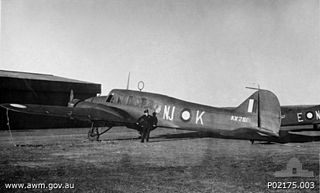
No. 73 Squadron was a Royal Australian Air Force (RAAF) maritime patrol squadron of World War II. It was formed in July 1942 and conducted patrols off the east coast of Australia until July 1944. The squadron was disbanded in September 1944.

Clackline is a locality in the Wheatbelt region of Western Australia, about 80 kilometres (50 mi) east-north-east of Perth.
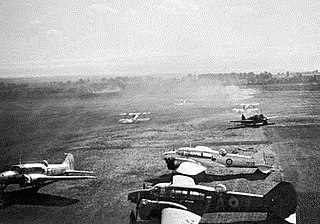
No. 2 Service Flying Training School was a flying training school of the Royal Australian Air Force (RAAF) that operated during World War II. It was formed in July 1940, under the command of Wing Commander Frederick Scherger. Responsible for intermediate and advanced instruction of pilots under the Empire Air Training Scheme (EATS), the school was based at RAAF Station Forest Hill near Wagga Wagga, New South Wales, and operated CAC Wirraway and Avro Anson aircraft. The Ansons were phased out in July 1941, and the school became an all-Wirraway unit. In 1942 the RAAF divided the personnel and equipment of No. 2 SFTS between Nos. 5 and 7 Service Flying Training Schools at Uranquinty and Deniliquin, respectively. No. 2 SFTS was disbanded that April, and the base facilities taken over by No. 5 Aircraft Depot.

On 29 September 1940, a mid-air collision occurred over Brocklesby, New South Wales, Australia. The accident was unusual in that the aircraft involved, two Avro Ansons of No. 2 Service Flying Training School RAAF, remained locked together after colliding, and then landed safely. The collision stopped the engines of the upper Anson, but those of the machine underneath continued to run, allowing the aircraft to keep flying. Both navigators and the pilot of the lower Anson bailed out. The pilot of the upper Anson found that he was able to control the interlocked aircraft with his ailerons and flaps, and made an emergency landing in a nearby paddock. All four crewmen survived the incident, and the upper Anson was repaired and returned to flight service.

The Aviation Heritage Museum is a museum created and maintained by the RAAF Association of Western Australia. It houses many military and civilian aircraft, aircraft replicas and aircraft engines, of types that have served in the Royal Australian Air Force or have relevance to aviation in Western Australia. It is located in the suburb of Bull Creek in Perth, Western Australia.

No. 4 Service Flying Training School was a flying training school of the Royal Australian Air Force (RAAF) during World War II. It was formed in February 1941, and commenced flying the following month. Responsible for intermediate and advanced instruction of pilots under the Empire Air Training Scheme (EATS), the school was based at Geraldton, Western Australia, and operated Avro Anson aircraft. Two reserve squadrons were formed in response to the outbreak of war in the Pacific, though they never saw action. Flying activity was reduced towards the end of 1943, and the school was disbanded in May 1945, having graduated over 1,000 pilots. It re-formed as No. 87 Operational Base Unit, which was renamed Care and Maintenance Unit (CMU) Geraldton in May 1946. CMU Geraldton was disbanded in September 1947.
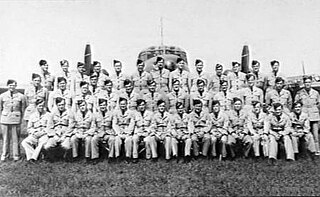
No. 3 Service Flying Training School was a flying training school of the Royal Australian Air Force (RAAF) during World War II. It was formed in September 1940, and commenced flying two months later. Responsible for intermediate and advanced instruction of pilots under the Empire Air Training Scheme (EATS), the school was based at RAAF Station Amberley, Queensland, and operated CAC Wirraway and Avro Anson aircraft. Two reserve squadrons were formed at the school in response to the outbreak of war in the Pacific, and the base fortified against air attack. In March 1942 the RAAF divided the staff and equipment of No. 3 SFTS between Nos. 1 and 6 Service Flying Training Schools at Point Cook, Victoria, and Mallala, South Australia, respectively. No. 3 SFTS was disbanded the following month.
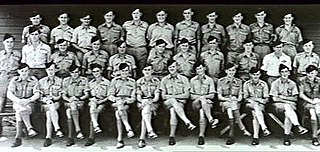
No. 6 Service Flying Training School was a flying training school of the Royal Australian Air Force (RAAF) during World War II. It was formed in August 1941, and commenced flying the following month. Responsible for intermediate and advanced instruction of pilots under the Empire Air Training Scheme (EATS), the school was based at RAAF Station Mallala, South Australia, and operated Avro Anson and Airspeed Oxford aircraft. The school formed a reserve squadron for Australia's defence after the outbreak of war in the Pacific in December 1941. Having graduated over 2,000 pilots, No. 6 SFTS completed its final training course in September 1945, and was re-formed as Care and Maintenance Unit Mallala in January 1946.

No. 8 Service Flying Training School was a flying training school of the Royal Australian Air Force (RAAF) that operated during World War II. It was formed in December 1941, and graduated its first course in March 1942. Responsible for intermediate and advanced instruction of pilots under the Empire Air Training Scheme (EATS), the school was based at RAAF Station Bundaberg, Queensland, and operated Avro Anson aircraft. It spawned two maritime patrol squadrons in early 1943, raised in response to increased Japanese submarine activity off Australia's east coast. Some of the school's aircraft were also attached to the Australian Army in 1944–45. No. 8 SFTS completed its final training course in December 1944, and was disbanded in July 1945.
Clackline School, later known as Clackline Primary School, was a school in the Wheatbelt town of Clackline, Western Australia. It opened in 1896, and was extended and renovated several times before relocating in 1954 to a new site on the same road. The school was closed down in 1976, but in 1980 became the temporary location of the Avon Valley Church's school. A monument commemorating British colonisation was erected in 1929, and remains in use as a stopping point on the Kep Track.

The Clackline Refractory, also known as Clackline Clay and Brick, is a heritage listed brickworks site in Clackline, Western Australia.
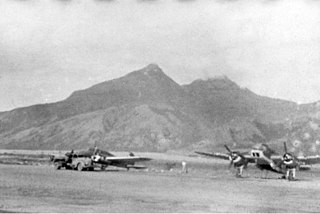
The Rescue and Communication Squadron was a Royal Australian Air Force (RAAF) squadron formed during World War II. Raised for service during the New Guinea campaign, the squadron existed between October 1942 and November 1943, and undertook a variety of support roles including search and rescue, transportation, reconnaissance and casualty evacuation. Upon disbandment, it was used to raise two new communications units.
References
- 1 2 "Avro Anson Memorial". Monument Australia. Archived from the original on 21 May 2014. Retrieved 20 May 2014.
- 1 2 Heritage Council (20 November 2013). "RAAF Anson Aircraft Memorial". State Heritage Office, Government of Western Australia. Archived from the original on 21 May 2014. Retrieved 20 May 2014.
- 1 2 3 Shire of Northam (4 June 2013). "RAAF Anson Aircraft Memorial". State Heritage Office, Government of Western Australia. Archived from the original on 21 May 2014. Retrieved 20 May 2014.
- 1 2 3 4 5 6 7 Department of the Environment. "Air Disaster Memorial, Avro Anson Rd, Clackline, WA, Australia". Australian Heritage Database. Commonwealth of Australia. Archived from the original on 20 May 2014. Retrieved 20 May 2014.
- 1 2 Mounsey, Colin (December 2008 – January 2009). Mounsey, Colin (ed.). "Mokine Memorial Service 2008". Air Mail. Royal Australian Air Force Association (WA Division): 3. Archived from the original on 21 May 2014. Retrieved 20 May 2014.
- 1 2 "Qld. Man in Air Crash". Sunday Mail . Brisbane. 11 October 1942. p. 3. Retrieved 20 May 2014– via Trove (National Library of Australia).
- 1 2 3 4 "Plane Tragedy". The West Australian . Perth. 12 October 1942. p. 2. Retrieved 20 May 2014– via Trove (National Library of Australia).
- 1 2 3 4 5 Mounsey, Colin (December 2010 – January 2011). Mounsey, Colin (ed.). "25th Anniversary of the Mokine Memorial Service". Air Mail. Royal Australian Air Force Association (WA Division): 3. Archived from the original on 25 January 2014. Retrieved 20 May 2014.
- 1 2 3 4 Russell, Deirdre, ed. (December 2013 – January 2014). "Mokine Memorial Ceremony". Air Mail. Royal Australian Air Force Association (WA Division): 5. Archived from the original on 25 January 2014. Retrieved 20 May 2014.
- 1 2 "Plaque No 91". Australia & the South-West Pacific Theatre. Old Haleians' Association. Archived from the original on 6 March 2014. Retrieved 20 May 2014.
- ↑ "Four Killed in W.A. Crash". The Sydney Morning Herald . NSW. 12 October 1942. p. 4. Retrieved 20 May 2014– via Trove (National Library of Australia).
- 1 2 "Air Crash Victim". The Daily News . Perth. 14 October 1942. p. 7 Edition: HOME EDITION. Retrieved 20 May 2014– via Trove (National Library of Australia).
- 1 2 3 4 5 Connelly, Denis, ed. (December 2013). "Commemorative Service at Mokine" (PDF). The Listening Post. Perth: The Returned & Services League of Australia WA Branch Incorporated. 36 (6): 25. Archived from the original (PDF) on 9 March 2014. Retrieved 22 May 2014.
- ↑ "Plane Crash Victims". The West Australian. Perth. 14 October 1942. p. 4. Retrieved 20 May 2014– via Trove (National Library of Australia).
- 1 2 "Memorial Unveiled". The Kalgoorlie Miner . WA. 19 December 1942. p. 2. Retrieved 21 May 2014– via Trove (National Library of Australia).
- ↑ Mounsey, Colin (December 2009 – January 2010). Mounsey, Colin (ed.). "The annual Mokine Memorial Service". Air Mail. Royal Australian Air Force Association (WA Division): 9. Archived from the original on 25 January 2014. Retrieved 20 May 2014.
- ↑ "Shire of Northam 2013/14 Budget" (PDF). Shire of Northam. 2013. p. 193. Archived (PDF) from the original on 5 February 2014. Retrieved 22 May 2014.
- ↑ "Approved Grants List – Print view". Lotterywest. Archived from the original on 13 November 2013. Retrieved 22 May 2014.